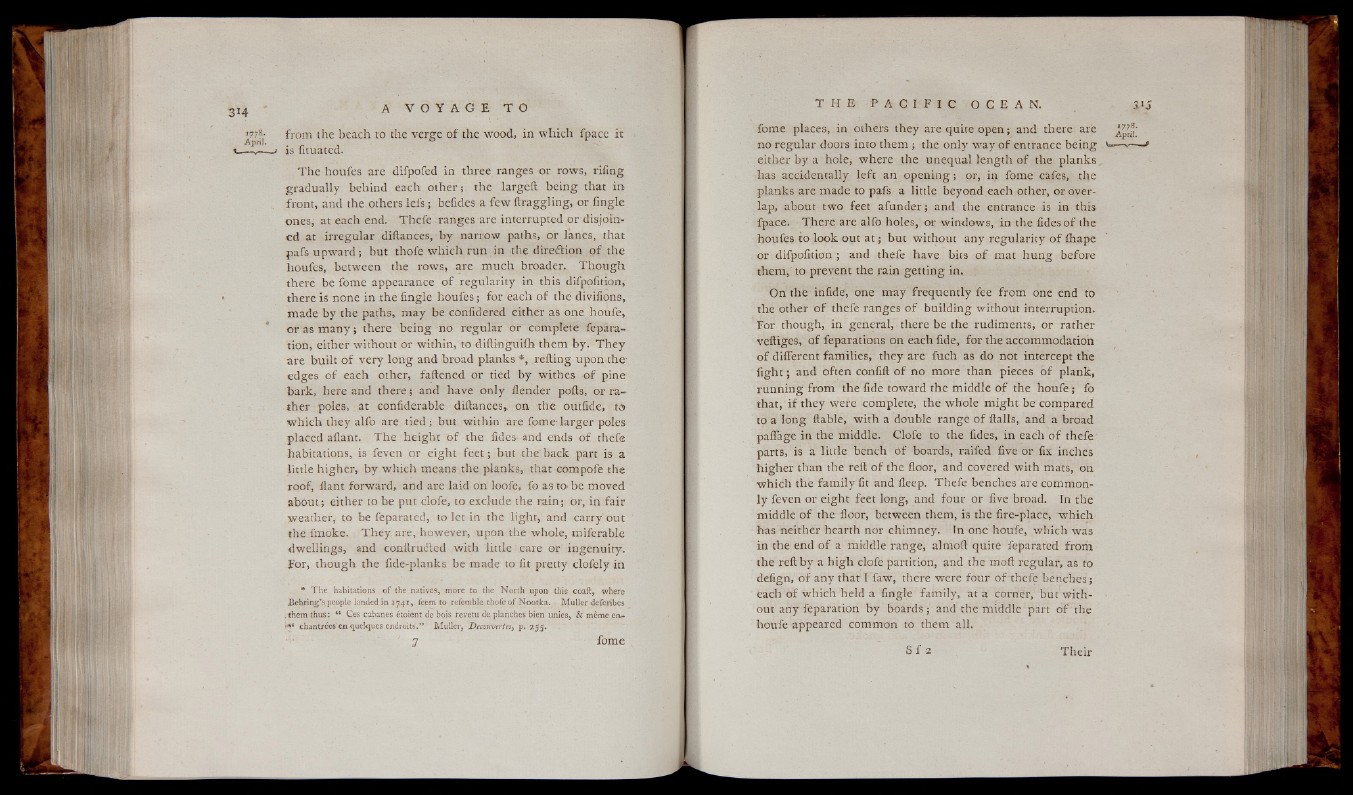
•778- from the beach to the ve rse o f the wood, in which Space it
April. *
— 1 is fituated.
T h e houfes are difpofed in three ranges or rows, rifing
grad u ally behind each o ther ; the largéft being that in
front, and the others lefs ; befides a few ftraggling, or fingle
ones,' at each end. Thefe ranges are interrupted or disjoined
at irregular diftances, b y narrow paths, or lanes, that
pafs upward ; but thofe w hich run in the direction o f the
houfes, between the rows, are much broader. T h o u gh
there be fome appearance o f -regularity in this difpofition,
there is none in the fingle houfes ; for each o f the divifions,
made by the paths, may be cônfidered either as one houfe,
or as many ; there being no regu lar or complete Separation,
either without or within, to diftinguifh them by. T h e y
are built o f ve ry long and broad planks *, reiling upon the-
edges o f each other, fattened or tied by withes o f pine
bark, here and there ; and have only Hender pofts, or rather
poles, at confiderable diftances,. on the outfide, ta
w h ich they alfo are tied ; but within are fome- la rge r poles
placed allant. T he height o f the lides- and ends o f thefe
habitations, is feven or e ight feet ; but the back part is a
little higher, by which means the planks, that compofe the
roof, liant forward, and are laid on loofe, fo as to-be moved
about.; either to be put clofe, to exclude the rain; Or, in fair
weather, to be feparated, to let in the light, and carry out
th e fm o k e . T h e y are, however, upon the whole, miferable
dwellings, and conftrufted with little care or ingenuity.
For, though the fide-planks be made to lit pretty clofely in
* T h e habitations o f the natives, more to the North upon this coaft, where
Behring’s people landed in 17419 feem to refemble thofe o f Nootka. Muller defcribes
i them thus : “ Ces cabanes étoient de bois revetu de. planches bien unies, & même en- 4* chantrées en quelques endroits.” Muller, Découvertes, p» 255.
' y fome
fome places, in others they are quite open ; and there are ¿778.
no regular doors into them ; the only w ay o f entrance b e in g <-—«—
either by a hole, where the unequal length o f the planks
has accidentally le ft an op en in g ; or, in fome cafes, the
planks are made to pafs a little beyond each other, or overlap,
about two feet afunder; and the entrance is in this
fpace. There are alfo holes, or windows, in the fides o f the
houfes to look out a t ; but without any regu larity o f fhape
or difpofition ; and thefe have bits o f mat h u n g before
them, to prevent the rain ge ttin g in.
On the infide, one may frequently fee from one end to
the other o f thefe ranges o f building without interruption.
For though, in general, there be the rudiments, or rather
veftiges, o f feparations on each fide, for the accommodation
o f different families, they are fuch as do not intercept the
f ig h t ; and often confift o f no more than pieces o f plank,
runn in g from the fide toward the middle o f the houfe ; fo
that, i f they were complete, the whole might be compared
to a long liable, with a double range o f flails, and a broad
paffage in the middle. Clofe to the fides, in each o f thefe
parts, is a little bench o f boards, raifed five or fix inches
higher than the reft o f the floor, and covered with mats, on
w h ich the fam ily fit and fleep. Thefe benches are commonly
feven or eight feet long, and four or five broad. In the
middle o f the floor, between them, is the fire-place, w hich
has neither hearth nor chimney. In one houfe, which was
in the end o f a middle range, almoft quite feparated from
the reft by a h igh clofe partition, and the moil regular, as to
defign, o f any that I faw, there were four o f thefe benches;
each o f which held a fingle family, at a comer, but w ith out
any feparation b y boards; and the middle part o f the
houfe appeared common to them all.